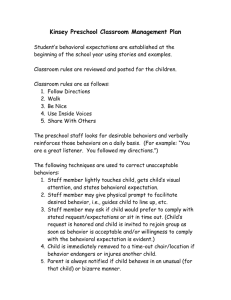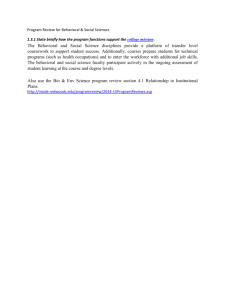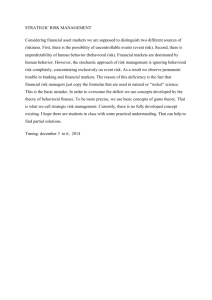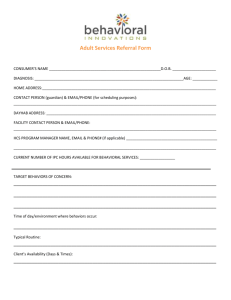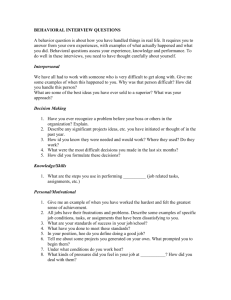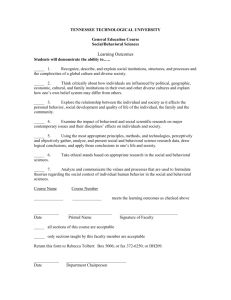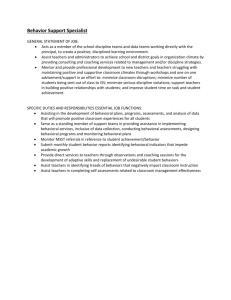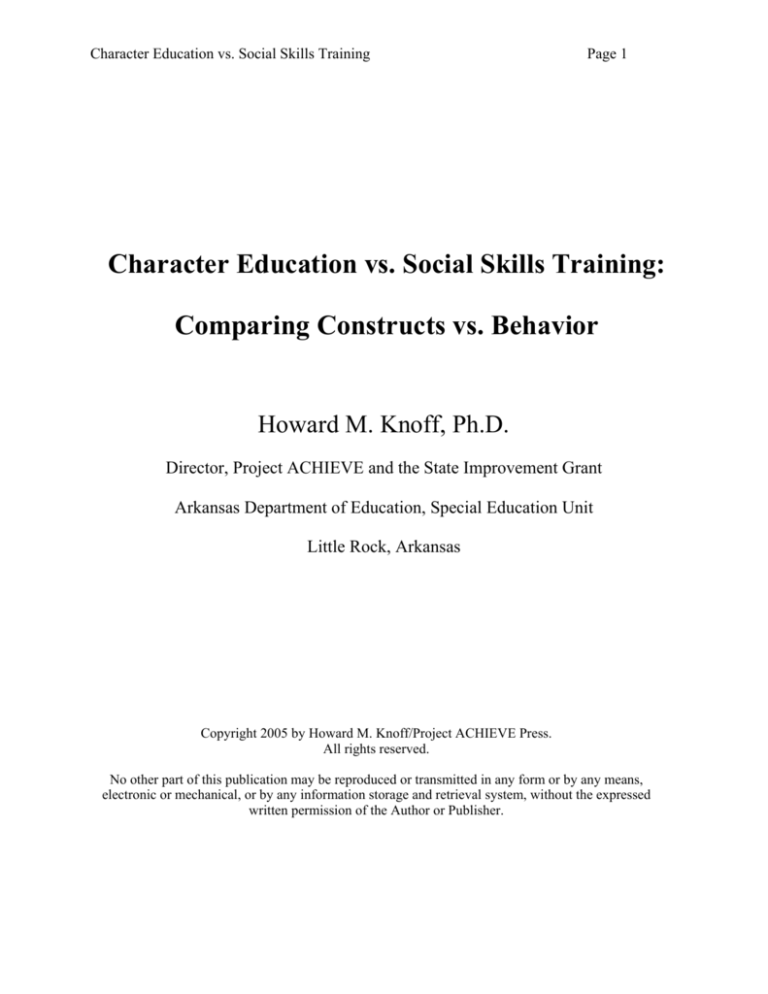
Character Education vs. Social Skills Training
Page 1
Character Education vs. Social Skills Training:
Comparing Constructs vs. Behavior
Howard M. Knoff, Ph.D.
Director, Project ACHIEVE and the State Improvement Grant
Arkansas Department of Education, Special Education Unit
Little Rock, Arkansas
Copyright 2005 by Howard M. Knoff/Project ACHIEVE Press.
All rights reserved.
No other part of this publication may be reproduced or transmitted in any form or by any means,
electronic or mechanical, or by any information storage and retrieval system, without the expressed
written permission of the Author or Publisher.
Character Education vs. Social Skills Training
Page 2
Character Education vs. Social Skills Training:
Comparing Constructs vs. Behavior
In 2002, Laura Bush invited about 150 educators, mental health practitioners,
and community advocates to the White House to attend a conference on “Character
and Community.” Before listening to Secretary of State Colin Powell, Secretary of
Education Rod Paige, and eventually the President of the United States, Mrs. Bush
asked us to disseminate the message that “Education can no longer just be about
the 3 R’s; it must be about the 4 R’s—Reading, Writing, ‘Rithmetic, and
Responsibility.” Indeed, much of the conference highlighted research and
examples of how children and adolescents in this country are learning to be more
responsible and to act “with character.”
The “character education” movement has existed, formally and informally, in the
United States for centuries. Starting, perhaps, in colonial America with the
precepts of religious tolerance and extending, during the past quarter century,
through movements inspired by individuals like Carl Rogers, Rudolph Dreikurs,
and others advocating “value clarification” curricula, educators in the 21st Century
now need to differentiate between character education and Character Education.
That is, we need to recognize that the published Character Education programs and
curricula that have flooded the educational marketplace may not result in the skills
and behaviors that are expected when we say character education, the movement
Character Education vs. Social Skills Training
Page 3
focused on teaching children social responsibility. And with the White House
touting its benefits, a new wave of Federal grant money available, and many school
districts and states following suit to require character education instruction in their
schools, the need to differentiate character education and Character Education is
even more pronounced.
As noted by Mrs. Bush, schools need to teach students to act in socially
responsible ways. This means that children and youth who are acting
“responsibly” should possess and behaviorally demonstrate the interpersonal,
problem-solving, conflict resolution, and coping skills that help them to get along
with others and handle socially challenging situations. While it is nice that
students can tell us what they need to do to act responsibly, it is more important
that they actually behave in responsible ways. In a phrase, “Talk is cheap;
behavior is golden.”
And yet, many of the Character Education programs on the market do not teach
behavior as an inherent and explicit goal and outcome of their curricula. Indeed,
many of these Character Education programs teach constructs of behavior and then
simply have students talk about these constructs. Some of these constructs, for
example, include such topics as “honesty,” “cooperation,” “friendship,”
“tolerance,” “justice,” “compassion,” “empathy,” “fairness,” and “equality.”
While these are important constructs, they must be introduced into a classroom in
developmentally appropriate ways to be successful, and the behaviors underlying
Character Education vs. Social Skills Training
Page 4
these constructs (i.e., honest behavior; cooperative behavior; tolerant behavior;
empathetic behavior) must be taught in order for the curriculum to be deemed
successful. Critically, some Character Education programs begin to teach some of
the constructs above during students’ early elementary school years—at times
when they do not have the cognitive ability to understand them. By way of
analogy, this is like teaching kindergarten students beginning mathematics by
teaching them the constructs of negative, positive, and absolute Base 10 number
system. Clearly, from a developmental perspective, behavioral outcomes with
younger students will occur more readily if we teach them responsible behaviors
and eventually, when they are cognitively ready, teach them the constructs that are
defined by their behavior.
In reviewing some of the Character Education programs being used in schools
around the country which we are expecting to be “behavioral change” programs, a
number of conclusions can be drawn:
1. Many of them talk about emotions and emotional control, rather than about
behaviors and self-control;
2. Many of them do not use behaviorally-sound teaching approaches,
focusing on concept rather than skills;
3. Many of them do not use developmentally-sensitive or cognitively-sound
teaching approaches, focusing instead on adult-desired rather than childappropriate outcomes;
Character Education vs. Social Skills Training
Page 5
4. Many of them are not evidence-based, meaning that they have not
demonstrated behavioral outcomes with diverse groups of students, across
meaningful periods of time, when compared with demographicallymatched students, and controlling for students’ prior knowledge or skill;
and
5. Many of them do not meet the behavioral goal of “generalization” in that
they can not be flexibly adapted to students from different cultures,
settings, situations, backgrounds, or life circumstances.
My point here is not to disparage Character Education programs. In fact, I
love them—when they are implemented at the appropriate age levels and with
appropriate goals and expectations. Indeed, if implemented, for example, as part of
a social studies curriculum at the late elementary and middle/high school levels,
when students are using their newly-developed higher ordered thinking skills to
weigh issues of values and ethics, they can help students to understand the history
and importance of tolerance and schools to create positive, caring, and inclusive
environments. Moreover, when integrated with a social skills training program
that begins in kindergarten (or before), and that teaches interpersonal, problemsolving, and conflict resolution behaviors and skills, you have the “responsibility
package” that, I believe, the President and Mrs. Bush are envisioning.
Character Education vs. Social Skills Training
Page 6
Thus, my real point is to suggest that the crucial goals of the character
education movement are better served through social skills training programs, and
to demonstrate this by providing a “consumer’s guide” of twelve criteria that most
effective, evidence-based social skills programs possess. Critically, the ultimate
goal of social skills training is to teach students, at their different levels of
maturation and development, to manage their own behavior—to demonstrate the
social responsibility desired by character education advocates. Comparable to
teaching students, academically, to be independent learners, behavioral selfmanagement means that students are able to demonstrate self-control, to self-select
responsible choices and to demonstrate appropriate behavior, to self-monitor and
self-evaluate their behavioral practice, and to reinforce themselves once successful.
To accomplish this, the evidence-based characteristics of an effective social
skills program, and thus, the criteria that can be used to evaluate and choose a
particular social skills program for school-wide implementation include the
following:
1. The social skills program must systematically use a social learning theory
approach that includes teaching, modeling, role-playing, and providing
performance feedback as a primary part of the instructional process. That is,
students need to behaviorally practice the social responsibility skills being taught
so that teachers can see, correct, reinforce, and validate students’ actual skill
proficiency. The program then must overtly plan and implement the transfer
Character Education vs. Social Skills Training
Page 7
(generalization) of social skills use in different settings, with different people, at
different times, and across difference situations and circumstances.
2. The social skills program must connect the training process to a buildingor grade-level positive discipline and behavior management system that holds
students accountable for their behavior and provides for implementation integrity.
Thus, beyond skill instruction, incentives for “good choices” and consequences for
“bad choices” must be present in order to motivate students’ use of their skills.
3. The social skills program must focus on both grade-level and wholebuilding implementation. Each grade level must teach the same social skill with
the same teaching steps at the same time if at all possible to build teaching and
implementation consistency across both students and staff. In the absence of
consistency, students learn to distrust, ignore, or resist existing incentives and
consequences, resulting in social skills that are not used.
4. The social skills program must use a universal or common language that
is easy for students to learn, facilitates cognitive scripting and mediation, and
facilitates the conditioning or reconditioning of prosocial behaviors and choices
leading to more and more automatic behavior. As most emotionally-linked
behavior is conditioned (like Pavlov’s dogs—think about your immediate
emotional and behavioral reaction to one of your spouse’s “looks”), new behaviors
are learned through a systematic conditioning process, and old, “inappropriate”
behaviors are altered through an “unlearning” and reconditioning process. In order
Character Education vs. Social Skills Training
Page 8
to do this, cognitive-behavioral research suggests that the behavioral practice of a
new or reconditioned skill must be linked with internal, language-based
mediational scripts that sequentially guides the practice (think about how you
learned to drive a “stick shift” car). Over time, and with repeated practice of the
“skill and script”, the new behavior eventually becomes “memorized” while later it
becomes automatic.
5. The social skills program must teach specific behaviorally-oriented skills
(not constructs of behavior) in explicit and developmentally appropriate ways, yet
the curriculum must be able to adapt to students’ individual language levels,
cultures, maturational levels, and needs. For example, while many programs teach
the skill of “listening,” the behavioral expectations for listening and the teaching
script underlying the behavior differ from preschool to elementary to middle to
high school.
6. The social skills program must provide a defined, progressive, yet
flexible, sequence of social skills that recognizes that some prerequisite skills must
be mastered before other, more complex skills are taught. For example, in order to
learn “accepting consequences,” most children and adolescents need to first learn
the “how to apologize” skill that is often embedded in the process. Beyond this,
the social skill program also must reflect the reality that social skills practice and
reinforcement never ends, and that social skills training occurs year-round.
Character Education vs. Social Skills Training
Page 9
7. The social skills program must employ an evidence-based pedagogical
approach to instruction that integrates behavioral teaching, continued practice and
application under increasingly realistic—yet controlled— conditions, and skillspecific reinforcement during actual, real-life "teachable" moments. Critically, the
program should acknowledge that there is no pedagogical difference between
teaching a social skill and teaching an academic skill.
8. The social skills program must demonstrate its effectiveness over time in
controlled and independent studies in real schools and applied school situations.
9. The social skills program must be designed for implementation by regular
classroom teachers who should be the primary instructors. This reflects the fact
that (a) all students need to learn and practice social skills, even if only to apply
them to school and classroom situations; (b) all regular classroom teachers need to
have their own classroom-based discipline and behavior management system, and
the social skills become a behavioral anchor to that system; (c) all students need to
behaviorally respond primarily to their regular classroom teachers, not to some
“specialist” who comes into the classroom to teach behavioral responsibility; and
ultimately (d) prosocial skills typically increase students’ academic engaged time
which, in turn, increases academic achievement.
10. The social skills program must teach sensible and pragmatic skills that
are needed by today's students and that can be applied, on a daily basis, by
preschool through high school students. For preschool students, these skills form
Character Education vs. Social Skills Training
Page 10
the foundation of self-control and self-management; for high school students, these
skills reinforce the importance of interpersonal skills, tolerance, and conflict
resolution.
11. The social skills program must be able to address behavior or
disciplinary problems or situations, as identified by both adults and students, that
occur in classrooms or in common areas of the school on an almost every day
basis.
12. The social skills program must include evaluation components that
assess treatment and implementation integrity, student and adult satisfaction, and
student outcomes, especially those behavioral outcomes for when students are
interacting with adults or with peers.
While they may overtly resist, most students want their classrooms and schools
to be structured and predictable, they expect the rules and expectations for their
behavior to be dependable and fair, and they trust that teachers will interact with
them with fairness and consistency. At the same time, however, if students are not
directly taught the interpersonal, coping, problem solving, and conflict resolution
skills that they need to demonstrate responsible behavior, no rules or expectations,
no incentives or consequences, and no amount of fairness and consistency will
matter. In the end, the character education movement is looking for tangible,
Character Education vs. Social Skills Training
Page 11
observable outcomes. While character constructs are important, social skill
behavior is essential.

